The Oxborrow Family - Blacksmiths and Engineers

The Oxborrow Family - Blacksmiths and Engineers |
 |
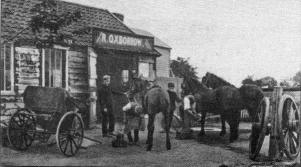
William Oxborrow was born in Bentley, Suffolk in 1812. The rural way of life in those times was very different to the one we see today - the picturesque Suffolk villages were a hive of agricultural activity and horsepower and manpower kept it all going. The roads were little more than cart tracks and the labour-force had to move around with the work - usually with their families in tow. Being part of this economy meant early starts, long journeys and backbreaking work.
William, like his father William before him, was not a wealthy man and seemingly followed the work. He moved to Bradfield in Essex and in 1834 he married Harriet Taylor in Great Oakley. From there they moved to Walton-on-the-Naze where their first child, William, was born in 1836. William had moved to Walton as he had progressed from an itinerant labourer to a journeyman blacksmith. This effectively meant that he was a fully qualified tradesman and whilst this meant he might have to travel to find work and still had to be employed by someone (journeyman were generally paid daily) he would be paid a lot more.
William was employed by Elizabeth Riddlesdell and worked at the forge in Kirby-le-Soken, which stood on land roughly where Easter Cottage stands today. Mrs. Riddlesdell was a widow and when she died in 1852 it was William that carried on the business. By then William and Harriet had 7 living children (another, James, had died aged just one year in 1839) and they were to have another, Robert, in 1855.
Although it might be expected that the eldest son, William, might carry on the business and although he stayed in Kirby long into his 30s he eventually moved with his family to Bradfield and later Great Bentley setting up as blacksmith in both locations.
It was actually the youngest son, Robert, who took over the business in Kirby and moved the forge to a new site opposite where Briarfields is today. He married Harriet Crampin in 1876 and they lived at Hive Villa, next to the forge, and had 7 sons between 1877 and 1896. The name Hive Villa came about as Robert was a keen beekeeper and the garden was full of hives. Beekeeping would become a family pastime for many years.
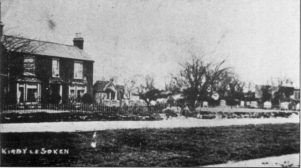
Agriculture had changed since William started out as a blacksmith and moved to the area and although the horse still ruled it had become more intensive and more mechanised. The growing population demanded their daily bread and the fertile soil of the Sokens was in great demand. The forge held accounts for all the gentlemen farmers and kept their horses shod and their implements in good repair - an essential and lucrative part of the rural economy.
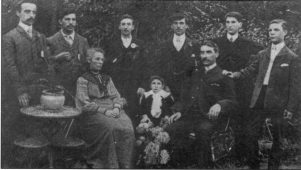
Robert handed over the business to his second son Bertie in 1915 - Bertie was born in 1879 and married Ada Garrod in 1904. They built and lived in Hazelmere near the forge where they had 6 children, later moving next door to Catalpa.
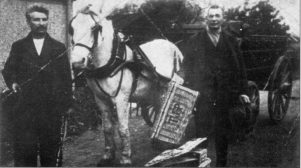
Bertie handed the business down to his eldest son Robert John (known as John) who had married Frances Feltham in 1937. They lived in Great Oakley and Kirby Cross before building Forge House at the bottom of Halstead Road and settling back in the village.
Like the generations before him John clearly travelled around a bit and had other interests beyond the forge. He was a qualified electrician and, amongst other things, rewired the Red Lion and looked after the secret Bombing Decoy site at Birch Hall during WW2. Being "reserved occupation" during WW2 meant that he not only had to try and keep the business running but also got seconded to Army or even Navy duty for weeks at a time. His wife Frances once reported "times were always hard while he was away but you always knew he was about as you would wake up and find a sack of sugar on the doorstep". He was also a keen motorcycle racer and regularly attended the Isle of Man TT Races.
John followed the increasing mechanisation of agriculture and also had a keen interest in all forms of motor transport. As the business changed he made extensive alterations to the forge and eventually pulled it down to accommodate the larger agricultural machinery of the day as well as offering services for private motor vehicles and safe petrol storage - the petrol pump had originally been very near the forge!
If John was staying with the farmers and their tractors his younger brother Jim was keen to carry on with metalworking and started another business down Maltings Lane - later known as Oxborrow Engineering.
So as the old forge site gained a huge new workshop, office, public toilets (John was proud that he had provided rest facilities where the local council had failed!) and three petrol pumps dispensing four-star, three-star and two-star, the business of heating and shaping metal continued in the village.
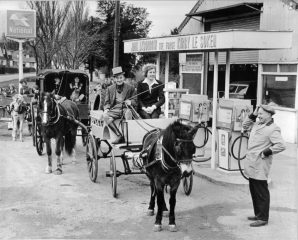
John and Frances had three children, John (known as Johnny), Graham and Katherine (known as Jill) and it was Graham who followed his father into the business and worked at the garage with Sid Leonard who started work at the forge when he returned from serving with the army in WW2.
Like his father before him Graham tried other things besides the family business and did think he would become a farmer before becoming what was by now a mechanical engineer at the forge. He attended college to learn all about the internal combustion engine and Ackerman steering. Meanwhile Johnny carried on the engineering tradition as a draughtsman and Jill went to work for ITN in London and then Paris.
Unlike today's car workshops where new parts are always fitted the engineers at the forge would regularly make up or repair things. They had a lathe, two pillar drills, welders and an array of hand tools. Experience and local knowledge were important - the old Landrover was always stocked with fire extinguishers during the harvest as the hot combine harvesters would become clogged with dust and catch fire - the men from the forge were often first on the scene. Once a customer rang from Frinton Golf Club where his car stubbornly refused to start, while the customer was on the phone John said "tell him to pull the mud out of the exhaust, he'll have backed into the bank" - sure enough he had and the customer was able to effect his own repair.
The forge was one of the centres of village life like the post office, the pubs and the church. It was amazing how a little crowd would appear at 11am and 4pm when the kettle went on - a bottle of Famous Grouse was on hand for old friends to keep out the chill in winter.
While village life seemed to continue undercurrents were starting to drag the village in a different direction. Agriculture was becoming extremely intensive and the village was starting to become more developed. One day someone walking into the workshop and said "I've just seen Strutt and Parker's new American tractor pulling a 10 furrow plough" - the old men knew it was another sign that the pace of change in agriculture and rural life was definitely not slowing down.
By the time John died in 1997 the village had almost changed beyond recognition and the local farmers had started to decide that farming on their scale had actually become uneconomic. The big farms were expanding - swallowing the old family farms or renting their lands and the subsidy system needed to be carefully navigated . Petrol sales had gone the same way as the supermarkets and big petrol companies had been fighting a bitter price war and the small, rural garages with their small tanks and low sales just couldn't compete. Add to that the transformation of the motorcar into a reliable, highly engineered machine that works for ten years and then gets scrapped and you see why all the small garages were closing.
A new generation of wealthy, older people had moved into Kirby driving up the house prices and not necessarily using the village facilities - many commuted to work or were retired.
Against this backdrop the next generation of Oxborrows pursued other careers and when Graham became ill in 2003 he decided to put the business up for sale. An unsurprising lack of interest in the old forge as a going concern meant that the site would be sold for redevelopment and so the contents were auctioned in July 2004 and the site sold to be redeveloped for housing. The auction was a surprisingly upbeat affair with many of the older villagers turning out to celebrate the end of an era and swap old stories of the life and times of the forge.
Village life in Kirby-le-Soken may have changed and two homes now sit on the old forge site but the Oxborrow family remain relaxed - they've just bent with the wind and moved on - much like William once did.
The William at the beginning of this family history was born in Bentley, Suffolk in 1813. His parents were William and Harriet (nee pear) who were married at Sproughton in 1807. William and Harriet seemed to move around the Ipswich area and had 6 children that we know of. By the 1851 census William was a widower and was lodging with Elizabeth Bishop at Copdock. He gives his birthplace as Nacton and his age as 67 making his year of birth 1784 or 1783. His death certificate in 1859 has him recorded as age 79, which has him being born some 4 years earlier in 1780 or 1779. Despite extensive research we cannot locate the birth of William Oxberry and the best theory is that he was born out of wedlock to a young Mary Oxbury and was brought up by his maternal grandparents, Edward and Jane Oxborrow from Burgh and later Ipswich. We would be very interested to hear from anyone who knows more about William Oxborrow (or Oxberry, Oxbury, Oxborough, Oxberow or similar corruption) born from 1779 to 1783, Mary Oxbury or Edward and Jane Oxborrow. Please mail the webmaster.